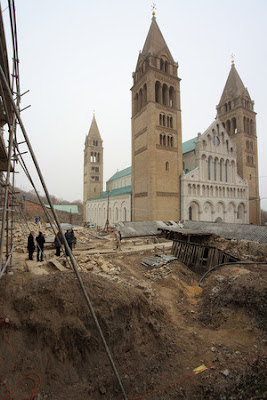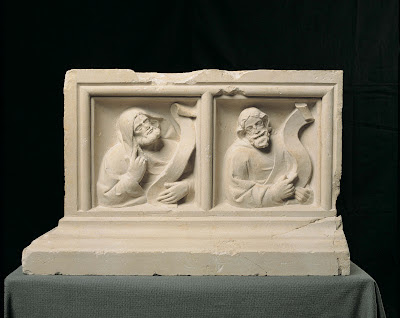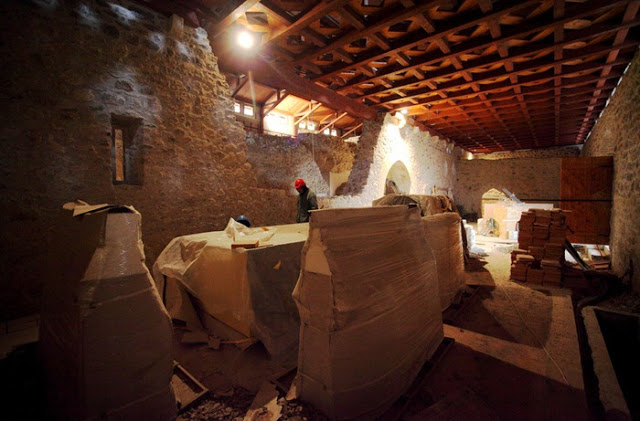Medieval History
- Medieval News From The End Of 2013
There were quite a lot of things I wanted to report on at the end of 2013. I hope to come back to these subject individually in the near future - for now, I can only give a brief listing of these news. Medieval palace chapel reopened at Esztergom After...
- In Memoriam Melinda Tóth
Art historian Melinda Tóth passed away in January 2013, at the age of 74. Melinda Tóth spent a lifetime researching Hungarian Romanesque art and was one of the leading scholars of the field. She worked until her retirement at the Art History Research...
- Medieval News In The Hungarian Press
I'm back from my vacation, and I am returning to blogging with a brief overview of news about medieval art and archaeology in the Hungarian press. Summer is naturally the chief season for archaeologists, so there are reports about various interesting...
- Destruction Of The Centers Of Medieval Hungary
On August 29 1526, the army of Suleiman the Magnificent defeated the Hungarian army at Mohács. King Louis II died on the battlefield, and the sultan's army marched on to take the capital, Buda. At that time, the Turkish army withdrew - but in 1541,...
- Late Antique And Medieval Buildings At Pécs In 3d Reconstructions
The town of Pécs is one of Europe's Cultural Capitals in 2010. Not much in terms of new buildings was completed by this year - but Pécs has a 2000 year old history, with remains of a number of very important Early Christian and medieval buildings....
Medieval History
The Medieval University of Pécs
 |
| General view of the site north of the cathedral Photo: muemlekem.hu |
Hungary's first university was founded in 1367 at Pécs, with faculties of philosophy, law and medicine (no theology). The university was created by the bishop of Pécs, Vilmos (William), with royal support and by a decree of Pope Urban V. The university was short-lived: already in 1395, King Sigismund created a new insitution at Óbuda, and the school at Pécs stopped working some time in the early 15th century (the University of Óbuda was unsuccessful, too). It is believed that the buildings of the University were located on the north side of cathedral, where in the 12-13th centuries the bishop's palace was erected. Indeed, excavations carried out there in 1980s unearthed a large Gothic building, built on the remains of an earlier, Romanesque structure. The topography of this area, however is rather complicated: among other structures the remains of a 14th-century chapel: the so-called Gilded Chapel of Our Lady (mentioned as such in a charter of Pope Boniface IX in 1401: capella deaurata beate Marie Virginis), founded by Bishop Nicholas (1346-1360). Remains of the chapel and the university dissapeared during the Ottoman Turkish conquest and the wars ensuing (Pécs was occupied in 1543).
The chapel and other remains on the north side of the cathedral were unearthed by Mária Sándor between 1978-1987). Among the most important finds on the site were the extraordinarily fine statues stemming from the former chapel. After this for many decades, the remains of the buildings stood under temporary roofs, while the sculptural fragments from the chapel languished in storage at the local county museum. There were many attempts to make the site accessible, but there was never any money for it - not even during preparations for 2010, when Pécs was European Capital of Culture (when a new visitor center was built for the Early Christian ruins, also located near the cathedral).
 |
| Fragment of a stone retable from the Gilded Chapel of Our Lady |
Last year, however, something finally happened - there was a brief new archaeological campaing to clarify some questions, and it was announced that the site will be opened to the public by this year. Along this process a lot of additional medieval architectural fragments have been recovered in the area, especially inside the later walls encircling the complex.
The area is now managed by the Hungarian State Holding Company, and a significant amount was set aside for the erection of a new protective building for the remains of the university and the chapel. In June it was announced that that the university building is ready for visitors, apart from some minor internal restoration tasks. The walls of the medieval fortress structure surrounding the cathedral complex have also been strengthened and a new walkway is being created around them. The opening of this area is scheduled for September, 2012. With this step finally the whole cathedral complex will be accessible to visitors, together with the very rich holdings of medieval sculpture and other remains. I wrote briefly before about the cathedral and the adjacent Cathedral Museum, which holds the Romanesque sculptures from the cathedral. The new area will make accessible the equally significant Gothic remains of Pécs.
 |
| Glimpse inside the new museum building at the site Photo: muemlekem.hu |
Additional reading:
Reports on a research project coordinated by Mária Sándor in 2001-2006, dedicated to the remains of the university and the chapel (with bilbiography).
The MA Thesis of Veronika Csikós, submitted at CEU Budapest in 2008, can be downloaded from the website of the University. The thesis deals with the statues of the Gilded Chapel of Our Lady.
A brief introduction to the site on the Pécs portal.
More information is available in Hungarian at the following sites:
Report on the discovery of carved stones last year, in the online heritage magazine, M?emlékem.hu.
Report on the new excavations at the chapel, on the online journal for medieval archaeology (Archeologia - Altum Castrum Online Magazin), maintained by the Visegrád Palace Museum (with a more detailed report by Gergely Buzás, a PDF-file with lots of images).
An image gallery on the website of the local online newspaper, showing the site in May 2012.
- Medieval News From The End Of 2013
There were quite a lot of things I wanted to report on at the end of 2013. I hope to come back to these subject individually in the near future - for now, I can only give a brief listing of these news. Medieval palace chapel reopened at Esztergom After...
- In Memoriam Melinda Tóth
Art historian Melinda Tóth passed away in January 2013, at the age of 74. Melinda Tóth spent a lifetime researching Hungarian Romanesque art and was one of the leading scholars of the field. She worked until her retirement at the Art History Research...
- Medieval News In The Hungarian Press
I'm back from my vacation, and I am returning to blogging with a brief overview of news about medieval art and archaeology in the Hungarian press. Summer is naturally the chief season for archaeologists, so there are reports about various interesting...
- Destruction Of The Centers Of Medieval Hungary
On August 29 1526, the army of Suleiman the Magnificent defeated the Hungarian army at Mohács. King Louis II died on the battlefield, and the sultan's army marched on to take the capital, Buda. At that time, the Turkish army withdrew - but in 1541,...
- Late Antique And Medieval Buildings At Pécs In 3d Reconstructions
The town of Pécs is one of Europe's Cultural Capitals in 2010. Not much in terms of new buildings was completed by this year - but Pécs has a 2000 year old history, with remains of a number of very important Early Christian and medieval buildings....
